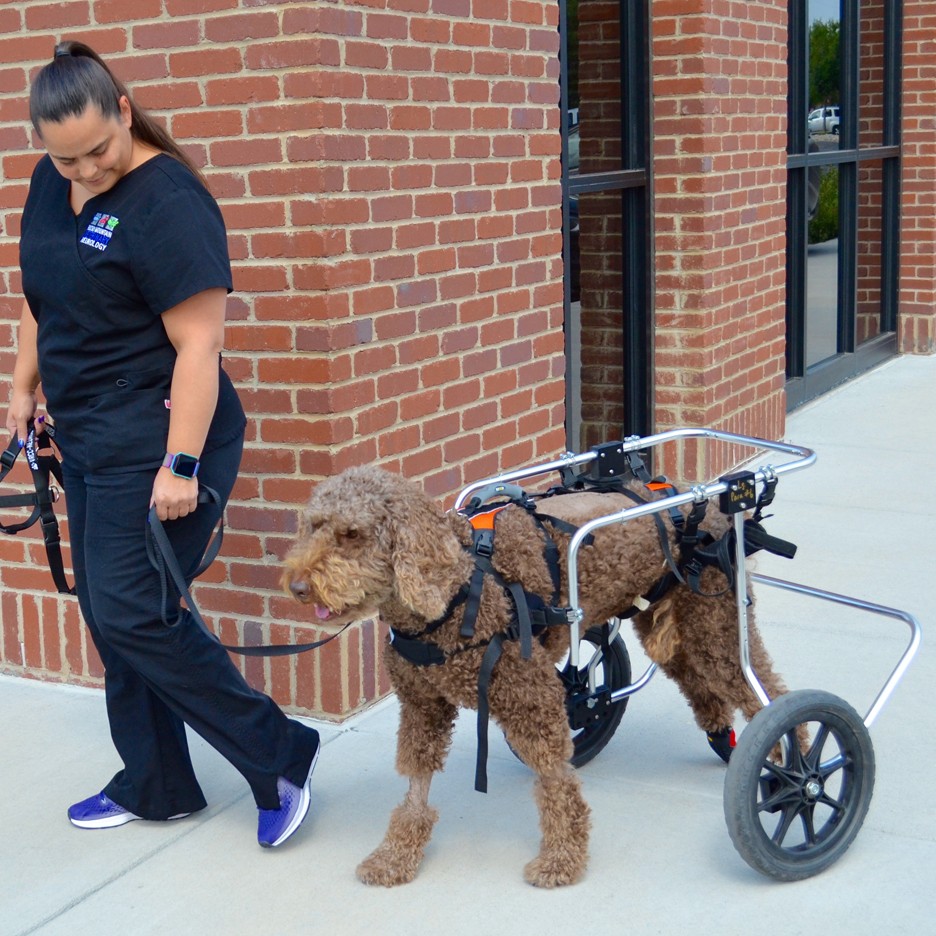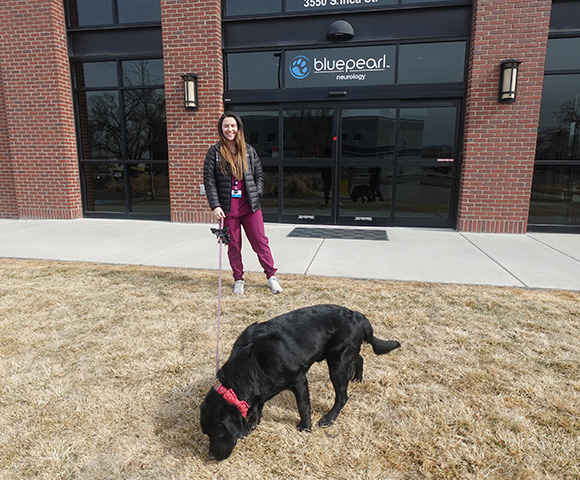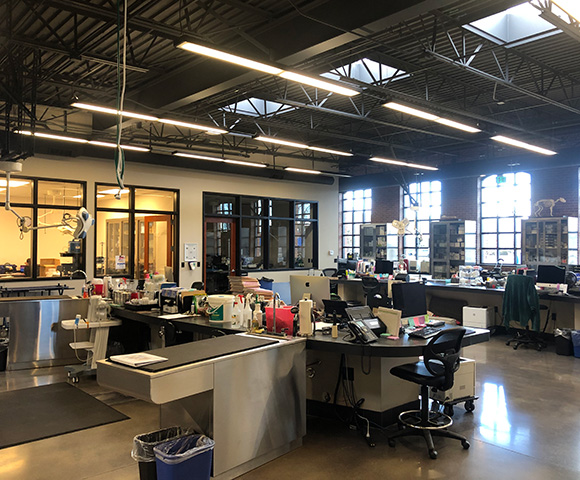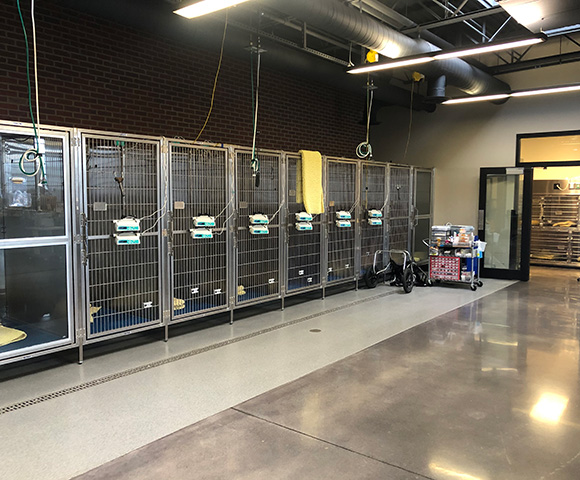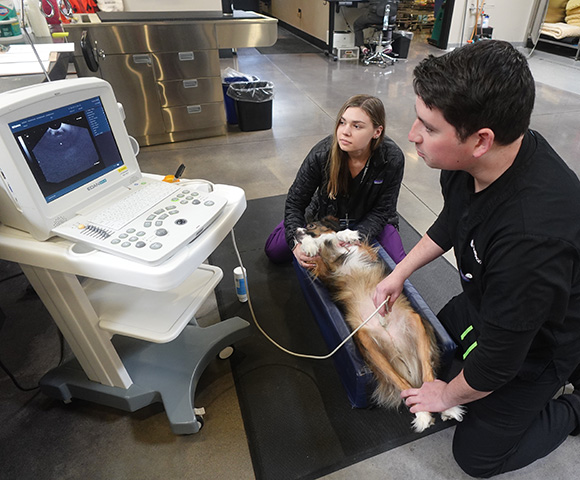BluePearl Pet Hospital in Englewood Colorado.
Our services.
Our
veterinarians.
About BluePearl Pet Hospital Englewood.
Frequently asked questions.
Intervertebral disk disease (IVDD) is a complex subject, and a strong understanding of the disease is critical for good decision-making. The intervertebral disk is the connector and shock absorber between each of the backbones (vertebrae).
Age-related and/or degenerative changes in the intervertebral disk can cause predisposition to disk herniation/prolapse/bulge/slip (all interchangeable terms referring to the same condition) where the soft center of the intervertebral disk moves or is squeezed out into a location where it does not belong. The consequence of this is inflammation, contusion and compression of the spinal cord and/or nerves. When this happens, the result is pain, weakness or even paralysis.
It is important to remember that signs of spinal pain, weakness, or paralysis are not limited to disk disease. Many different conditions of the spine can result in these same signs; disk disease just happens to be one of the more common causes of these signs in dogs.
The spinal cord, nerves and intervertebral disks cannot be seen on plain x-rays. Sometimes changes in x-rays suggest the possibility of disk-related problems, but a definitive diagnosis cannot be made with x-rays alone.
Advanced imaging like CT or MRI is used to definitively diagnose disk herniations (slipped, bulging, protruding disks) as these modalities allow us to visualize the intervertebral disks and spinal cord. They also provide more detail about the overall health of the spine (vertebrae) than simple x-rays.
Here are a few key differences between MRI and CT imaging:
- MRI is the ‘gold standard’ of imaging modality when looking at the spine or brain. It is a precision instrument that allows us to look inside specific regions of the body with exquisite detail.
- MRI is excellent at differentiating different types of disease processes. CT is not as good at differentiating disease processes; many things can be missed or misinterpreted by CT, which MRI will detect accurately.
- CT is fast and can be used to screen large areas of the body quickly; the cost is loss of detail in specific body parts. MRI is slow and is used to look at very specific regions in great detail.
- Both modalities require the patient to be completely motionless, so heavy sedation or full anesthesia is required.
- CT exposes the patient to relatively high doses of ionizing radiation while MRI uses no radiation at all.
Treatment options for disk-related problems – or the “best” treatment for disk-related problems – vary. Depending on the dog, the best treatment option may be any combination of:
- Surgery
- Time and rest
- Medication
- Alternative options like acupuncture
Not all disk problems are alike. Variations in severity, location of the problem in the spine, type of dog affected, age, and concurrent medical conditions are all important considerations when prescribing the most appropriate treatment in an individual dog – or cat, for that matter.
Very often, milder signs associated with some disk-related problems will go away with nothing more than time and rest. In other cases, the signs may be severe, recurring or just fail to improve. In those cases, surgery is often the best treatment.
Certain types of disk problems can be addressed with surgery with greater than 90% success; this means getting your dog back to normal, or very near normal. Other disk-related problems may have lower surgical success rates and higher complication rates.
Yes. MRI is available in our hospital and can often be done on the same day as your consultation. A consultation with the doctor is necessary before an MRI scan can be arranged. This is to ensure that MRI is the most appropriate, efficient, cost-effective and safest test for your pet. You will always be given a complete and accurate estimate of costs before the MRI scan is scheduled.
Yes. There is no ionizing radiation with MRI. We use full gas anesthesia and MRI-compatible anesthesia monitoring equipment. A certified veterinary technician stays in the MRI room with your pet monitoring their anesthesia during the entirety of the MRI.
Our neurologist can discuss the preliminary MRI results right away and your pet can go home immediately following the MRI scan.
No. Spinal surgery for uncomplicated disk problems can be very simple. Surgical success rates for uncomplicated disk problems are greater than 90%. Not all disk problems are uncomplicated, but most are. Most dogs go home the morning after surgery, but some go home the same day.
The total recovery time varies. The more severely affected a dog is before surgery, the longer it will take to recover. That said, even in paralyzed dogs, most are up on their feet again around two weeks after surgery.
While a direct referral from your family veterinarian is not required, it is recommended. It's best to see your veterinarian first to ensure they agree that your dog has signs consistent with disk disease and that a referral is recommended.
Seizures are the outward signs of abnormal, excessive brain activity. This activity may start due to disease within the brain itself or from elsewhere in the body.
There are many causes for seizures, including diseases within the brain and diseases elsewhere in the body, such as the liver and kidneys. Different seizure classifications are as follows:
- Idiopathic epilepsy: For dogs, if your pet is between the ages of 6 months and 6 years, and completely normal in between seizures, the most likely cause is “idiopathic epilepsy.” We don’t often know what causes this condition, but it is most likely due to genetics. In cats, idiopathic epilepsy is rarer but may occur in animals older than 6 years.
- Structural epilepsy: Seizures can be caused by other types of brain disease, including cancer, inflammatory (autoimmune) disease, some infectious diseases, trauma to the brain, and strokes. Some pets are born with brain abnormalities (developmental abnormalities) that predispose them to seizures. This is often classified as “structural epilepsy.”
- Reactive seizures: Seizures can also be caused by systemic disease. For example, with liver disease, toxins may not be cleared from the body and may build up. These toxins can act on the brain to induce a seizure. In young and very active dogs, low glucose levels can result in seizures. For these reasons, it is important for your veterinarian to perform blood work to rule out disease elsewhere in the body that may cause a seizure. These seizures are classified as “reactive seizures.”
Your veterinarian will consider your pet’s full medical history and current symptoms. A neurological exam helps us see if there are other neurological deficits and, if so, where in the brain they may be. Blood work is useful in identifying and treating any disease within the rest of the body that may cause seizures.
MRI is useful for helping to diagnose causes of seizures that originate in the brain. With MRI, we can identify signs of inflammatory (autoimmune) disease, tumors, infectious disease and strokes. Identifying a cause helps us establish an appropriate treatment plan. If the brain is normal, then the condition is most likely idiopathic epilepsy.
Another test that may be recommended is a “CSF tap” (spinal tap). This allows us to collect some of the fluid surrounding the brain and spinal cord (cerebrospinal fluid, or CSF), to help us identify inflammation, infections and some forms of cancer.
Yes. When people think of a seizure, they picture a generalized grand mal seizure characterized by loss of consciousness, paddling limbs, frothing at the mouth, urination and defecation during the seizure. This is known as a generalized tonic-clonic seizure, the easiest type of seizure to recognize.
Focal seizures are those in which a small area of the brain is affected, manifested as changes in one part of the body. These include facial twitching, salivation, vocalization, fly-biting, jaw-chomping, or abnormal movement of one part of the limb. Your pet may be conscious during these episodes. Focal facial seizures are common in cats.
Complex partial seizures are often characterized by abnormal behavior, where the pet may seem to be hallucinating, or in an altered state. With these seizures, pets may not be conscious or responsive to you. These seizures can be difficult to diagnose.
There are three phases to a seizure:
- Pre-ictal (or prodromal, aura): This is the period leading up to the seizure. Some owners report that their pets are more clingy than usual, whiny, or they may hide.
- Ictal: This is the period during the seizure. It usually lasts one to two minutes and stops on its own.
- Post-ictal phase: Following the seizure, many pets experience a post-ictal phase. During this period, they may be disoriented and pace around the room. Some dogs are blind for a short while after the seizure but usually regain sight. Pets may be abnormally sleepy or may wish to eat. This period can last anywhere from a few minutes to days.
Try to stay as calm as possible. Never put your hand in your dog’s mouth – you may accidentally be bitten if you try to manipulate their head or jaw.
If possible, try to make sure your dog is on the ground, away from furniture.
Try to time the seizure. If you're not used to seizures, they may seem much longer than they actually are.
A seizure is much worse for you to experience than it is for your pet. We know from talking to people who have seizures that they are not painful.
Seizures are often treated with anti-seizure medications to reduce their frequency and severity. Several anti-seizure medications are available, and the particular medication recommended will depend on factors such as the type of seizure, the severity of the seizure, and any other existing health conditions your pet may have.
In humans, there are surgical options for treating seizures, although those are not currently available in pet patients.
Reactive seizures (those caused by metabolic disturbances within the body) usually resolve when the underlying cause is treated. These do not usually require anti-seizure medications.
We commonly start an anti-seizure medication if a pet has two seizures. If your pet has had only one seizure, and it lasts less than 3 minutes, your veterinarian may recommend waiting to see if they have another. If your pet has less than one seizure every 6 months, then they may not need anti-seizure medications.
Unfortunately, there is no way to predict how frequent your pet’s seizures will be. For a pet on anti-seizure medications, less than one seizure within 4-6 weeks is considered reasonable control. If your pet’s seizures are more frequent, they may need medication. Some pets will go for months without a seizure, while for some unfortunate patients, we are not able to gain good control of seizure frequency.
Generally speaking, once a pet has started to have seizures warranting an anti-seizure medication, they will need to continue it. Stopping anti-seizure medications may result in seizures that may subsequently be more difficult to control.
We understand there may be some concern when your pet starts a new medication. However, untreated seizures can be very dangerous for your pet. Every seizure primes the brain in a way that makes additional seizures more likely. Therefore, untreated seizures may lead to longer and more frequent seizures that are difficult to control. Repetitive seizure activity or seizures lasting 5 minutes or longer can result in dangerous increases in body temperature. In some instances, seizures can cause permanent brain damage or death. If your veterinarian recommends an anti-seizure medication, it is important to give your pet the medication consistently.
If your pet has a seizure that lasts 5 minutes or longer, or if they have one seizure after another without full recovery in between, your pet should be taken to the hospital for treatment.
Some pets have cluster seizures, which means they have multiple seizures within a 24-hour period. If your pet has more than 2 seizures within a 24-hour period, they should be brought to the hospital.
In both cases, ongoing seizure activity within the brain requires additional medications, commonly given as an intravenous drip, to help stop the seizures.
This is specific to each patient. Many pets’ seizures are well controlled and they live a normal, happy life. For some, however, seizure control is difficult, and seizures may increase in frequency over time. Some patients, sadly, become “refractory” to treatment, meaning that anti-seizure medications no longer help control their seizures. Quality of life may be a concern for these patients and their owners.
To help reduce the likelihood of refractory conditions, we recommend regular check-ups to make sure that your pet’s seizures are treated appropriately with anti-seizure medications. Keeping a diary of seizure severity and frequency helps identify trends over time that may indicate the need for a change in anti-seizure medications.
There are some differences between seizures in dogs and cats. Idiopathic epilepsy in cats is less common than in dogs, but it may occur in cats at older ages more than dogs. Common causes of seizures in cats include structural brain changes caused by infectious diseases, tumors or birth defects.
While cats may have full, general tonic-clonic seizures, some seizures look very different in cats. Frequent signs of seizures in cats include facial twitching, salivation and vocalization. If your cat experiences these signs, please have them evaluated by a veterinarian immediately.
There are several other conditions that can be confused with seizures. These include:
- Vestibular disease (balance disorders)
- Heart disease that causes collapse
- Movement disorders
- Muscle cramps and repetitive contractions
- Head or body tremors
- Sleep disorders
- Behavioral issues
Some of these can be difficult to distinguish, even for trained veterinary neurologists. Your veterinarian will take a full medical history and perform a full exam to help rule out these various conditions. Additional diagnostic tests may help identify conditions that look like seizures. If you can safely take a video of your pet’s condition, this can be very helpful.
Your veterinarian may refer you to see a veterinary neurologist for a neurological exam, further work-up and advice on treatment. If you're concerned that your pet has a seizure disorder — or something that looks like a seizure — it's a good idea to seek an appointment with a veterinary neurologist.
Your veterinary neurologist will take a full medical history to identify any conditions that may help explain the development of seizures.
If your pet is currently taking medications, please bring these to the appointment.
Your neurologist will perform a complete physical and neurological exam to help isolate the cause of your pet’s seizures. Once this has been performed, your neurologist will discuss possible reasons for the seizures and will suggest a plan for diagnosis and treatment.
Each seizure case is very different, and your neurologist will be able to discuss the best options for you and your pet.
Testimonials.
“Dr. Maguire and the team were the best!!! Dr. Maguire’s years of expertise and the team’s professional, loving care provided five-star quality care for my cherished 13-year-old dog’s delicate cervical spine surgery. We traveled from Salt Lake City for this expert care and I couldn’t be happier with the outcome! Thank you from the bottom of my heart.” — Stephanie M.
“We just wanted you to know how very grateful we are for our Hannah, and the life you’ve given back to her and us. I have no doubt that you have heard this before. Your dedication to animals is a gift to all who are lucky enough to see you. You did her surgery, fitting her into your already tight schedule. She was a spaz to say the least, but you patiently took care with her, and me. She is now doing so well, I see some of her puppy attitude emerging.
It is a given that your pet is a member of your family. You could see Dr. Maguire had her best interest at heart. I bless him for this every day.” — Laura K.
“I wanted to take this opportunity to thank you again for everything you did on behalf of my beloved, Chootchie. He’s apparently totally recovered from his injury and from the surgery. As best I can tell, he doesn’t think or worry about any of this for a moment. He’s simply back enjoying his life – chasing squirrels, playing tug of war, burrowing under the blankets, sitting on peoples’ laps, and most importantly, refusing to do anything you want unless you give him a treat. It’s wonderful having him back and it’s wonderful he’s been able to return to fully enjoying his life again.
In addition to your skill as a surgeon, I also wanted to thank you for all the other things you did: your obvious love and concern for Chootchie; your enormous sensitivity to my worries; your willingness to make yourself available to me, by phone, whenever I might need this; your patience in answering all my questions – even when I was asking them for the second or third time.” — Richard B.
